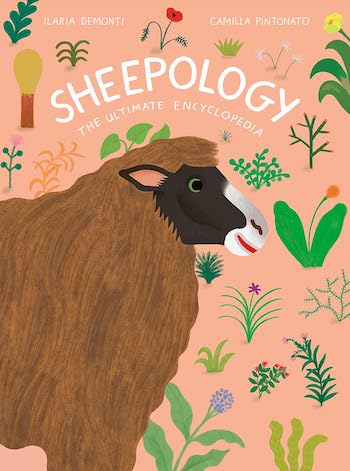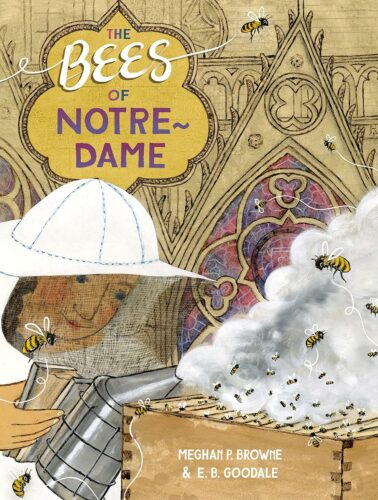Children’s Book Reviews: Animal Adaptation and Inspiration
By Cyrisse Jaffee
Tired of the same old animal books? Here’s a series filled with fascinating facts, large and small, about farm animals, and an inspiring tale of the bees of Notre Dame.
Sheepology: The Ultimate Encyclopedia by Ilaria Demonti. Illustrated by Camilla Pintonato. Princeton Architectural Press, 2022.
Pigology: The Ultimate Encyclopedia by Daisy Bird, illustrated by Camilla Pintonato. Princeton Architectural Press, 2021.
Chickenology: The Ultimate Encyclopedia by Barbara Sandri and Franceso Giubbilini. Illustrated by Camilla Pintonato. Princeton Architectural Press, 2021.
The Bees of Notre Dame by Meghan P. Browne. Illustrated by E.B. Goodale. Random House Studio, 2023.

Did you ever wonder how many domesticated pigs there are on Earth? (1 billion.) Or whether chickens have excellent hearing? (They do.) Or the first kind of cheese made by humans? (Probably sheep’s milk; the oldest piece of cheese ever discovered is 7,200 years old.).
It’s these kinds of facts — historical, cultural, scientific, biological — accompanied by colorful and appealing illustrations by Camilla Pintonato, that make this series good for browsing and perfect for school or classroom libraries. Nicely designed in full-page spreads with lots of headings and subheadings, the writing is sprightly and witty, and fun to dip in and out of. (Younger readers will need a grownup’s help with vocabulary and concepts.) Each of the books provide a wealth of facts, including the animal’s development, habitats, diet, breeds, and so on. Reproduction is handled matter-of-factly, with frank descriptions of mating, pregnancy, and birth. There’s a useful table of contents but no index or reading list.
Like the other previously published titles, Sheepology, the latest in the series, provides information about not only the animal itself, but the relationship the species has with humans, now and in the past. For instance, the importance of sheep around the world is reflected in the variety of breeds that have adapted to different landscapes, as well as the diversity of shepherds who tend to the sheep, from Algeria to Mongolia, India to Italy. A section on how cheese is made includes how sheep’s milk cheese is used in world cuisine. “The history of humankind and that of wool are tied together by a double thread,” the narrative explains, “spinning and weaving have strong symbolic meanings, and they are celebrated in many legends around the world.” Many villages and towns developed along the traditional drovers’ roads — the route along which shepherds drove their flocks.
City and country kids alike will find plenty of details to enjoy. And, since kids love being experts on the subject, there’s lots of time to learn everything you ever wanted to know about sheep, chickens, or pigs before your next visit to a farm.

In, The Bees of Notre Dame, the animals in question are bees, specifically, the bees who live on the top of Notre Dame, Paris’s famous cathedral. The lively illustrations show Paris bustling in the spring, when “people pop up like tulips from underground after working, riding, and resting through short winter days.” Although not entirely accurate — people walk the streets of Paris through all seasons — the narrative sets the scene to spotlight a special hive of bees. First introduced in 2013 as part of an effort to boost the bee population by installing hives throughout the city, the bees have thrived atop Notre Dame. The author draws a comparison between the cathedral itself, the result of “thousands of hands” who “worked together for hundreds of years to make something amazing under the spire,” and the bee colony, where the bees (most of whom are female) work together to nourish and sustain the hive.
Then on an April morning in 2019, a catastrophic event takes place — a raging fire that partially destroys the historic cathedral. Amazingly, the bees survived. And, although the cathedral is badly damaged, many, many workers began the arduous process of reconstruction and restoration. In the book, the sun “pushes the chill from the air” and encourages the bees to “make the colony strong with new life!” Now, once again, says the author, the sun rises to say to Paris and people around the world, “Come! Rebuild. Work with each other. You are stronger together. Just like the bees.”
The message is clear, although the text itself might be confusing to younger readers. Luckily, an afterword provides much-needed context about the bees, the fire, and the aftermath. (A glossary would have been helpful; the Recommended Reading list is odd, including kids’ books about bees as well as The Hunchback of Notre Dame by Victor Hugo!) For budding beekeepers or for educators who are teaching about bees, this is a story with a hopeful, “sweet” ending (pun intended) that blends current events and beekeeping facts.
Cyrisse Jaffee is a former children’s and YA librarian, a children’s book editor and book reviewer, and a creator of educational materials for WGBH. She holds a master’s degree in Library Science from Simmons College and lives in Newton, MA.
